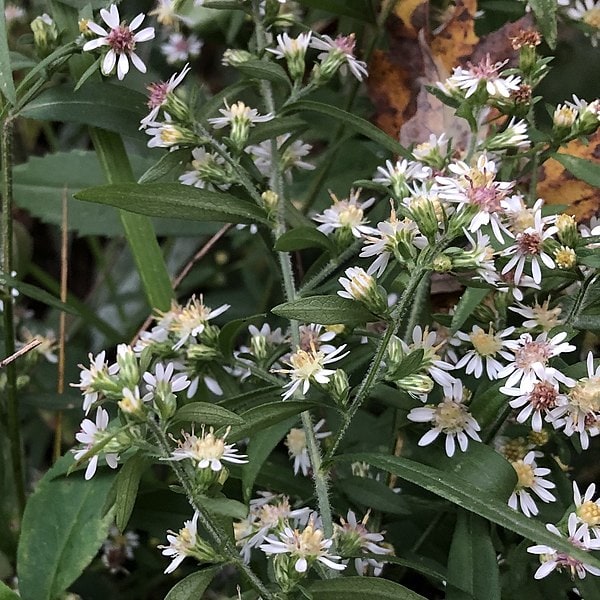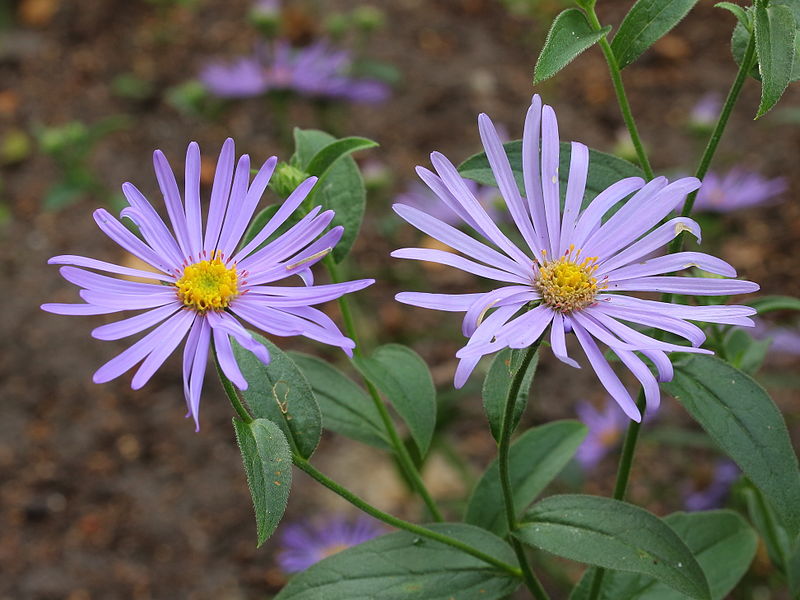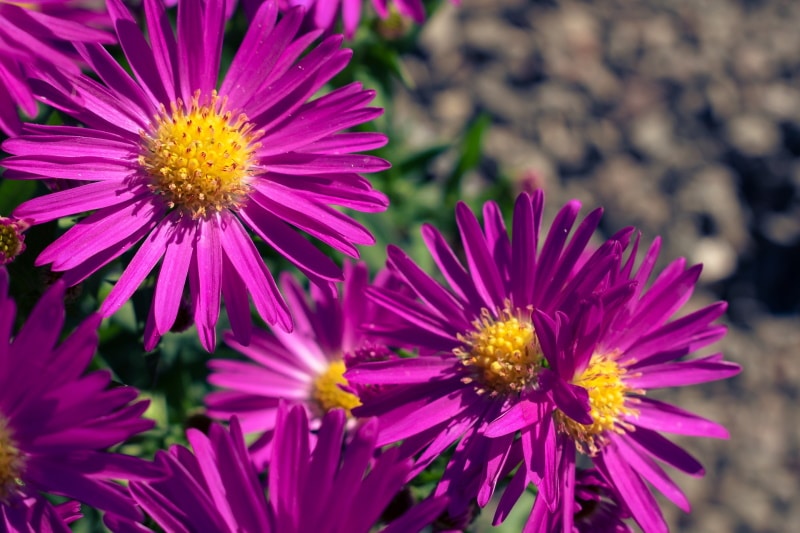15 Types of Aster Flowers to Grow at Home (With Pictures)
-
Pete Ortiz
- Last updated:

Asters are a family of upright flowers that can grow to a height of several feet, although the actual height does depend on the type of Aster you choose. There are many different varieties, including those that are better suited to cold climates and those that are ideal for more temperate conditions. Typically, though, Asters are considered hardy plants that do especially well in rockeries and borders, and they look great in wild gardens. They are also considered great plants for attracting pollinators like butterflies and bees.
Below are 15 types of Aster flowers you can grow at home.
The 15 Types of Aster Flowers You Can Grow at Home
1. Alpine Aster

| Latin name | Aster alpinus |
Originally native to Europe and Asia, the Alpine Aster can grow in climate zones 4 to 7. It typically grows in the hills and mountains and will grow to a height of about 1 foot. With a single flower per stem, the Alpine Aster looks especially pretty when blowing in the gentle breeze, and it comes in white, purple, or pink.
2. Aromatic Aster

| Latin name | Symphotrichum oblongifolium |
The Aromatic Aster grows in zones 3 to 8 and may be found growing wild in the Midwest and Northeast, and occasionally in the South. It grows well in full sun, is tolerant of less-than-perfect soil conditions, and may grow to a height of up to 3 feet so is good for filling gaps as well as for wild gardens.
3. Blue Wood Aster

| Latin name | Symphotrichum cordifolium |
The Bue Wood Aster is a bushy Aster that can grow up to 2 feet or slightly taller. It enjoys full sun but will also grow in partial shade and it will flower for several weeks. Its flowers are smaller than a lot of other variants at less than 1 inch across. Its neutral color means that it will blend with almost any other color in your garden.
4. Golden Aster

| Latin name | Chyrsopsis mariana |
The Golden Aster, or Maryland Aster, is native to America and grows in eastern and western areas at the roadside and in parks and fields. It has golden petals surrounding a golden center, grows to approximately 1 foot in height, and looks similar to the Daisy, which it is closely related to.
5. Calico Aster

| Latin name | Symphotrichum lateriflorum |
The Calico Aster is another native Aster that grows in zones 3 to 8. It is a perennial with a pink-red center and white petals. It especially enjoys moist wooded areas and, if given the right conditions, does not require much in the way of maintenance. It can grow up to 3 feet tall, although it can also be controlled and kept down to closer to 1 foot tall.
6. Aster Monch

| Latin name | Aster x frikartii |
The Aster Monch is a Swiss hybrid that can struggle with winter conditions and wet soil, but may grow in zones 5 to 10. It has lavender blue rays and a golden center, grows to between 2–3 feet high, and its flowers measure approximately 2 inches across.
7. New England Aster

| Latin name | Symphotrichum novae-angliae |
Native to zones 4 to 8, the New England Aster is readily seen growing wild and it blooms from late summer, typically falling back when the first frost hits. It can be a highly prolific grower but to achieve this, it does require soil with good drainage and that is organically rich. It grows well in full or partial shade and has light purple flowers with an orange center.
8. Purple Dome

| Latin name | Symphotrichum novae-angliae |
The Purple Dome is actually a cultivar of the New England Aster, but it will only reach a height of around 2–3 feet, which means that it is easier to manage and maintain. It is also known to produce more flowers. Its compact size makes it suitable for planters, as well as gardens, and its bright purple rays make it a colorful addition.
9. New York Aster

| Latin name | Symphotrichum novi-belgii |
The New York Aster is another native Aster that is similar to the New England Aster although there is some difference. The New York has slimmer stems and can grow as tall as 6 feet high. This height and slim stem mean that you may need to stake the stems to prevent them from breaking under the weight of the flower.
10. Kickin Carmine Red Aster
| Latin name | Symphotrichum novae-angliae |
The Kickin Carmine Red Aster is another cultivar of the New England Aster and is even more prolific than the Purple Dome. The plant is blanketed with purple flowers, which have a red tinge, especially around the center of the bloom. The Kickin Carmine Red Aster is very easy to grow and doesn’t require any maintenance to keep it in great shape.
11. Silky Aster

| Latin name | Symphotrichum sericeum |
Native to the Central Plains region, the Silky Aster will grow in zones 4 to 8. It prefers full sun, and it does need soil with good drainage to get the best results. It will grow to roughly the same width as height and will achieve a height of up to 2 feet. It is called Silky Aster because it has fine hairs on the leaves and stem.
12. Triumph Aster
| Latin name | Aster x alpellus |
At home in zones 3 to 9, the Triumph Aster is smaller than a lot of the other types, growing to about 1 foot tall. It does well in wildflower gardens and meadows. It prefers full sun but can be grown in partial shade, and it will produce more flowers if the water is kept moist but not allowed to get too wet.
13. Snowbank Aster

| Latin name | Boltonia asteroids |
The Snowbank Aster grows in regions 4 to 9 and has a yellow-green center with white rays that are almost rectangular in shape. It can grow to heights of 3 feet or more, although it is possible to maintain a shorter height with regular pinching, and the stems should be strong enough to support the weight of the flower.
14. White Monte Casino
| Latin name | Symphotrichum pilosum var pringlei |
The Monte Casino Aster comes in a range of colors and its small blooms make it popular in flower displays as a filler. It is similar to the Daisy, grows in zones 5 to 9, and will grow to a height between 2–3 feet if it is not pinched to maintain a shorter growth.
15. Wood’s Purple Aster

| Latin name | Symphotrichum novi belgii |
The Wood’s Purple Aster is a dense plant that has a yellow center and purple rays. It prefers full sun but will tolerate partial shade and is especially ideal for edging. It grows to about 1 foot tall and the same width and is a common addition to butterfly gardens, wild gardens, and used in coastal gardens.
In Conclusion
There are a great many types and cultivars of Aster, many of which are native to areas across the US, and this range means that whatever color and style you’re aiming for in your garden, whether it is a wild garden or a manicured one, you can find an Aster to match. Above, we have named 15 that you can consider growing in your garden but there are many others.
Featured Image Credit: Piqsels
Contents



